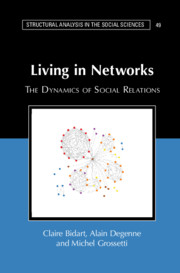Book contents
- Living in Networks
- Structural Analysis in the Social Sciences
- Living in Networks
- Copyright page
- Contents
- Figures
- Tables
- Preface
- Acknowledgments
- Introduction
- Part I Foundations of a Sociology of Relational Dynamics
- Part II Networks and Their Dynamics
- Part III Networks and Social Worlds
- 8 Networks Have a Spatial Dimension
- 9 Soft Segregation
- 10 Relationships and Networks As Resources
- 11 Unequal Networks
- 12 Networks Online and Offline
- Conclusion
- References
- Index
- Structural Analysis in the Social Sciences
11 - Unequal Networks
from Part III - Networks and Social Worlds
Published online by Cambridge University Press: 27 October 2020
- Living in Networks
- Structural Analysis in the Social Sciences
- Living in Networks
- Copyright page
- Contents
- Figures
- Tables
- Preface
- Acknowledgments
- Introduction
- Part I Foundations of a Sociology of Relational Dynamics
- Part II Networks and Their Dynamics
- Part III Networks and Social Worlds
- 8 Networks Have a Spatial Dimension
- 9 Soft Segregation
- 10 Relationships and Networks As Resources
- 11 Unequal Networks
- 12 Networks Online and Offline
- Conclusion
- References
- Index
- Structural Analysis in the Social Sciences
Summary
If relationships can be resources, how are they distributed? Are there "relational inequalities" as there are income inequalities? Like in other areas of social life, in relational matters not everyone is in the same boat. The environment in which one was brought up, the studies one followed, the profession one practices, life events and, of course, personal choices shape for each person a network that bears the traces of these experiences. There are large and small networks, family-centered networks, and others that are much more open, as well as dense and less dense networks. Some are made up of executives and wealthy people, others are made up of less fortunate people. Some span a large "social surface," reaching out to diverse backgrounds, others are concentrated in a very small world. Results that highlight relational inequalities are presented, followed by a discussion on the processes that produce and amplify them.
- Type
- Chapter
- Information
- Living in NetworksThe Dynamics of Social Relations, pp. 255 - 280Publisher: Cambridge University PressPrint publication year: 2020

